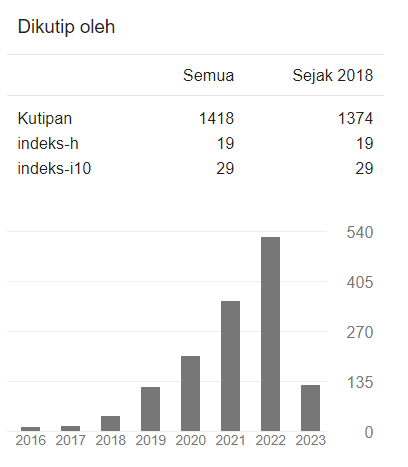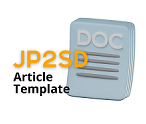Pengembangan E-Modul Bangun Datar Berbasis Teori Multiple Intelligence untuk Siswa Kelas IV SDN Ngupasan
DOI:
https://doi.org/10.22219/jp2sd.v10i1.20249Abstract
The rapid development of technology has invaded the world of education over time. This, of course, must be balanced with the quality and professionalism of teachers. Teachers must be rich in information and technology mastery to build mature learning concepts. Of course, in order to generate student activity in learning, it also needs to be supported by learning tools that the teacher has prepared. The current pandemic condition makes students study online. In such conditions, teaching materials are needed to help students master the material independently. Electronic modules can be developed and integrated with the theory of multiple intelligences in learning to build students' concepts and thinking skills in learning maximally. The results of the multiple intelligence-based e-module research developed are feasible to use because they meet the valid, practical, and effective criteria. Based on the validity test conducted by media experts, material experts, and teachers, the average score was 3.85. The practicality test through a student response questionnaire conducted with a limited and wide-field trial obtained an average score of 3.64 and was categorized as effective in learning completeness with 84%.
Downloads
References
Branch, Robert Maribe. 2009. Intrustional Design: The ADDIE Approach. Springer Sience:USA
Charisma, Jeaniver Yuliane dan Aslim Asnam. 2018. Pengembangan Bahan Ajar Matematika Berbasis Masalah Berorientasi pada Kemampuan Pemecahan Masalah Matematis dan Prestasi Belajar Matematika. Indonesian Journal of Mathematics Education Vol. 1, No. 1, Oktober 2018, pp: 34~46 p-ISSN: 2654-3907 , e-ISSN: 2654-346X
Diana, M., Netriwati, & Suri, F. I. (2018). Modul Pembelajaran Matematika Bernuansa Islami dengan Pendekatan Inkuiri. Desimal, 1(1), 7–13.
Ditjen Pendidikan Indonesia.2017.Panduan Praktis Penyusunan E-modul.Jakarta
Dwiqi, G. C. S., Sudatha, I. G. W., & Sukmana, A. I. W. I. Y. (2020). Pengembangan Multimedia Pembelajaran Interaktif Mata Pelajaran IPA Untuk Siswa SD Kelas V. Jurnal EDUTECH UNDIKSHA, 8(2), 33–48.
Gumilang, M. R., Wahyudi, & Indarini, E. (2019). Pengembangan Media Komik dengan Model Problem Posing untuk Meningkatkan Kemampuan Pemecahan Masalah Matematika matematis merupakan salah satu secara interaktif , inspiratif , menyenang- melakukan penguasaan bahan dan materi. Journal of Mathematics Education IKIP Veteran Semarang, 3(2), 185–196.
Illahi, T. A. R., Sukartiningsih, W., & Subroto, W. T. (2018). Pengembangan Multimedia Interaktif Pada Pembelajaran Materi Jenis-Jenis Pekerjaan Untuk Meningkatkan Kemampuan Berpikir Kritis. Jurnal Kajian Pendidikan Dan Hasil Penelitian, 4(3).
Istiningsih, & Nisa, A. F. (2015). Implementasi multiple intelligences dalam pendidikan dasar. Jurnal Pendidikan Dasar Islam, 7(2), 181–196.
Kharisma, J. Y., & Asman, A. (2018). Pengembangan Bahan Ajar Matematika Berbasis Masalah Berorientasi pada Kemampuan Pemecahan Masalah Matematis dan Prestasi Belajar Matematika. Indonesian Journal of Mathematics Education, 1(1), 34–47.
Mauluah, L., Sulistyowati, E., & Rokhimawan, M. A. (2015). Pembelajaran Matematika Dengan Pendekatan Multiple Intelligences Untuk Siswa SD / MI Di Bantul. MAGISTRA, 6(2), 64–78.
Mulyatiningsih, Endang.2011.Riset Terapan.Yogyakarta:UNY Press
Munir.2012.Multimedia: Konsep dan Aplikasi dalam Pendidikan. 2012.Bandung:Alfabeta
Nugroho, I. A., & Surjono, H. D. (2019). Pengembangan Multimedia Pembelajaran Interaktif Berbasis Video Materi Sikap Cinta Tanah Air Dan Peduli Lingkungan. Jurnal Inovasi Teknologi Pendidikan, 6(1), 29–41.
Peraturan Pemerintah Tahun Republik Indonesia.
Permatasari, A. I., Mulyani, B., & Nurhayati, N. D. (2014). Efektivitas Penggunaan Model Pembelajaran Joyful Learning Dengan Metode Pemberian Tugas Terhadap Prestasi Belajar Siswa Pada Materi Pokok Koloid Siswa Kelas XI IPA SMA Negeri 1 Simo Tahun Pelajaran 2012/2013. Jurnal Pendidikan Kimia, 31(1), 117–122.
Purnomo, Yoppy Wahyu.2015.Pembelajaran Matematika Untuk PGSD. Jakarta:Penerbit Erlangga
Sugiyono.2016.Metode Penelitian Pendidikan(Pendekatan Kuantitatif, Kualitatif, dan R&D).Bandung:Alfabeta
Wahyugi, R., & Fatmariza. (2021). Pengembangan Multimedia Interaktif Menggunakan Software Macromedia Flash 8 Sebagai Upaya Meningkatkan Motivasi Belajar Siswa Sekolah Dasar. Jurnal Ilmu Pendidikan, 3(3), 785–793.
Widyatmoko, Galih dan Ali Muhtadi. 2017. Pengembangan Multimedia Pembelajaran Interaktif Berbentuk Game Untuk Menstimulasi Aspek Kognitif Dan Bahasa Anak TK. Jurnal Inovasi Teknologi Pendidikan Volume 4, No 1, April 2017 (38-49).
Zaini, H. M., & Jumirah, R. (2016). Pengembangan Perangkat Pembelajaran Topik Ekologi Terhadap Keterampilan Berpikir Kritis Siswa Madrasah Aliyah. Jurnal Pendidikan Biologi Indonesia, 2(1), 39–47.
Downloads
Published
Issue
Section
License
Copyright (c) 2022 Jurnal Pemikiran dan Pengembangan Sekolah Dasar (JP2SD)

This work is licensed under a Creative Commons Attribution-ShareAlike 4.0 International License.
Authors who publish with Jurnal Pemikiran dan Pengembangan Sekolah Dasar (JP2SD) agree to the following terms:
- For all articles published in Jurnal Pemikiran dan Pengembangan Sekolah Dasar (JP2SD), copyright is retained by the authors. Authors give permission to the publisher to announce the work with conditions. When the manuscript is accepted for publication, the authors agree to automatic transfer of the publishing right to the publisher.
- Authors retain copyright and grant the journal right of first publication with the work simultaneously licensed under a Creative Commons Attribution-ShareAlike 4.0 International License that allows others to share the work with an acknowledgment of the work's authorship and initial publication in this journal.
- Authors are able to enter into separate, additional contractual arrangements for the non-exclusive distribution of the journal's published version of the work (e.g., post it to an institutional repository or publish it in a book), with an acknowledgment of its initial publication in this journal.
- Authors are permitted and encouraged to post their work online (e.g., in institutional repositories or on their website) prior to and during the submission process, as it can lead to productive exchanges, as well as earlier and greater citation of published work (See The Effect of Open Access).

This work is licensed under a Creative Commons Attribution-ShareAlike 4.0 International License.


















